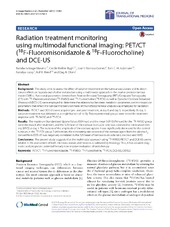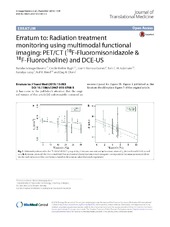| dc.contributor.author | Arteaga-Marrero, Natalia | |
| dc.contributor.author | Brekke Rygh, Cecilie | |
| dc.contributor.author | Mainou-Gomez, Jose Francisco | |
| dc.contributor.author | Adamsen, Tom Christian | |
| dc.contributor.author | Lutay, Nataliya | |
| dc.contributor.author | Reed, Rolf K | |
| dc.contributor.author | Olsen, Dag Rune | |
| dc.date.accessioned | 2016-03-23T09:35:23Z | |
| dc.date.available | 2016-03-23T09:35:23Z | |
| dc.date.issued | 2015-12-18 | |
| dc.Published | Journal of Translational Medicine. 2015, 13(1):383 | eng |
| dc.identifier.issn | 1479-5876 | en_US |
| dc.identifier.uri | https://hdl.handle.net/1956/11742 | |
| dc.description | Erratum published in: Journal of Translational Medicine 2016, 14:59 | |
| dc.description.abstract | Background: This study aims to assess the effect of radiation treatment on the tumour vasculature and its downstream effects on hypoxia and choline metabolism using a multimodal approach in the murine prostate tumour model CWR22. Functional parameters derived from Positron Emission Tomography (PET)/Computer Tomography (CT) with 18F-Fluoromisonidazole (18F-FMISO) and 18F-Fluorocholine (18F-FCH) as well as Dynamic Contrast-Enhanced Ultrasound (DCE-US) were employed to determine the relationship between metabolic parameters and microvascular parameters that reflect the tumour microenvironment. Immunohistochemical analysis was employed for validation. Methods: PET/CT and DCE-US were acquired pre- and post-treatment, at day 0 and day 3, respectively. At day 1, radiation treatment was delivered as a single fraction of 10 Gy. Two experimental groups were tested for treatment response with 18F-FMISO and 18F-FCH. Results: The maximum Standardized Uptake Values (SUVmax) and the mean SUV (SUVmean) for the 18F-FMISO group were decreased after treatment, and the SUVmean of the tumour-to-muscle ratio was correlated to microvessel density (MVD) at day 3. The kurtosis of the amplitude of the contrast uptake A was significantly decreased for the control tumours in the 18F-FCH group. Furthermore, the eliminating rate constant of the contrast agent from the plasma k el derived from DCE-US was negatively correlated to the SUVmean of tumour-to-muscle ratio, necrosis and MVD. Conclusions: The present study suggests that the multimodal approach using 18F-FMISO PET/CT and DCE-US seems reliable in the assessment of both microvasculature and necrosis as validated by histology. Thus, it has valuable diagnostic and prognostic potential for early non-invasive evaluation of radiotherapy. | en_US |
| dc.language.iso | eng | eng |
| dc.publisher | BioMed Central | en_US |
| dc.rights | Attribution CC BY | eng |
| dc.rights.uri | http://creativecommons.org/licenses/by/4.0 | eng |
| dc.subject | PET/CT | eng |
| dc.subject | CWR22 | eng |
| dc.title | Radiation treatment monitoring using multimodal functional imaging: PET/CT (18F-Fluoromisonidazole & 18F-Fluorocholine) and DCE-US | en_US |
| dc.type | Peer reviewed | |
| dc.type | Journal article | |
| dc.date.updated | 2016-02-25T14:34:10Z | |
| dc.description.version | publishedVersion | en_US |
| dc.rights.holder | Copyright 2015 The Authors | en_US |
| dc.identifier.doi | https://doi.org/10.1186/s12967-015-0708-5 | |
| dc.identifier.cristin | 1282730 | |


